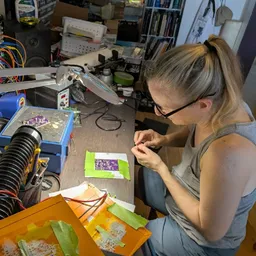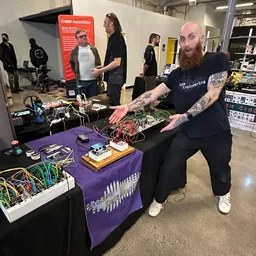Kris here.
Today I want to talk to you about some new (and some ongoing) things here, what will change, what won’t change, and why. It’s a long one, but as you’ll see, we’re aiming for transparency here, so there’s a lot to talk about.
Noise Engineering Core Value: Sustainabilitas
We talk a lot about sustainability here at NE. Part of this is because I come from the world of conservation biology, but also it’s just a big part of who each of us is. So this year when we talked about our core values as a team, we realized a glaring omission: Sustainability. While we had long since put it into practice where we could, we hadn’t put it into words. So we remedied that.
Our core values now include Sustainabilitas: We care about the impact our business has on the planet. We strive to minimize our footprint, including keeping up to date on best practices, giving back through conservation-oriented campaigns, using fewer, recycled, or lowest impact materials wherever possible, and communicating our sustainability efforts to our customers.
Why do the words matter?
We revisit our core values every year to make sure we’re living up to them. Beyond routine upkeep, formalizing our values by writing them down is a great way for us to make sure we are being the company we want to be.
And yes, all of our core values have fake Latin names. We are dorks. But you knew that.
1% for the Planet®
We are so excited to announce that as of January 1, 2023, we are an official 1% for the Planet Business Member.
Currently, only 3% of philanthropic giving goes to the environment. Our planet needs more support and the 1% for the Planet® network is on a mission to change that.
As a member, we commit to donating a minimum of 1% of our revenue to environmental causes. The 1% for the Planet® team vets the organizations that we donate to for accountability, but doesn’t act as a middleman: we donate directly to the causes. Each year, we will submit to independent auditing to ensure that we have met the requirements for certification.
We will continue to support conservation efforts, and this makes us accountable to live up to who we want to be as a company.
Changes to packaging and what’s in the box
Bags
If you’ve purchased our products, you know that we pack modules in pink bubble wrap bags. In addition to being cushioning for the product, these are anti-static bags that are thought to minimize the risk of electrostatic discharge which could fry IC components on the modules.
Over time, we’ve found that they don’t really protect the modules (I have often wondered just what a certain shipper who will remain nameless does to these packages to damage them so), so we are working with our manufacturer to move away from them. Coming soon, in the near-term, you’ll see a foam insert that holds the modules in place in the box and prevents them from bouncing around. This should decrease breakage and result in fewer people with modules broken out of the box. Sadly, I can’t control the unnamed shipper and their propensity for possibly playing football (American or European, take your choice) with our packages.
In the longer term, we hope to move to a paperboard insert that will replace the foam insert. Our distributor is still working out sourcing for this, and we’ll keep you posted as things progress.
Screws
We’ve noticed the prevalence—nay, domination—of Knurlies. So we recently asked a question of the week about whether people use the screws we package with modules in the box. An overwhelming number of responses said no (or “No, I use Knurlies”).
So we decided to stop including them. It’s not a huge move, and to be clear, this is NOT a cost-cutting move. This is simply a small move toward cutting waste.
A number of people mentioned that they did use them when they first started, though, so we have added screws (bags of 50, black and silver, M2.5 and M3) to our shop for purchase. In a few months, we hope to also add a thumbscrew option as well, but we’re still working on sourcing.
A couple of people astutely pointed out that either way, it should be clear what is in the box. We haven’t been clear about that in the past, so we have added a “what’s in the box” section to each hardware product page to help (thanks for the suggestion!).
Packaging
For as long as we can remember, we’ve used white product boxes, mostly out of habit. But as we went through all the things we could address (Sustainabilitas!), the bleaching of the pulp for the white boxes was one of them. Most mills use chlorine and chlorine-based compounds for bleaching. The effluent from these mills is, well, not great.
So we decided to get rid of the white boxes and go to unbleached kraft boxes.
We are also moving to paper tape from plastic tape. Once we saw the stats on plastic tape (that stuff lasts FOREVER), we were a bit appalled and offered to split the cost of the machine required for the paper tape with our distributor. Once they saw the stats, they just purchased the machine.
We also have an impromptu “internal recycling program” both here at NE and at our distributor. When we receive packages here, we reuse as many of the boxes and the internal void fill as possible, and recycle whatever we can’t reuse.
Void fill (the stuff that keeps product boxes from bouncing around within a shipping box) is a work in progress. We don’t have anything to report at this point, but it is on our radar.
We make tangible products
There are a few obvious, unfixable things that apply to all electronics companies. We have to ship products, and those products are made from parts that we source from around the world. The parts in any electronics are also not the most environmentally friendly parts. While we have from the outset avoided vactrols due to the presence of cadmium, the reality is that electronics have a footprint. This is true. Our goal here is not to pretend this isn’t the case, but to acknowledge this and ask what we can do to ameliorate it.
Shipping is one of our biggest carbon footprint contributors
We make hardware products. They have to reach you. There’s no way to do this without shipping. Furthermore, those products are made of parts. Those parts are made all over the world; in many cases, they are simply not available locally. Shipping is a fact of life for making tangible goods.
But that still means that we are shipping things all over, and we’re trying to figure out how to best approach this. To that end, we have a few solutions we are in the process of enacting.
- Our shop website is based on Shopify and while we take several forms of payment, Shopify has committed to making any purchase made with ShopPay carbon neutral.
- ShopPay isn’t an option for everyone, so we’re also working on adding other options for carbon offsets, such as:
- An opt-in for you, via the app EcoCart. EcoCart adds approximately 1-2% of your order total to the order and applies it to carbon offsets.
- An offset partner we can work with directly. We are working on identifying one that would be a good fit for us and have narrowed to a few options. We don’t have full details yet, but we’re workinonit. This is something we want to get set up soon. Once this is up and running, a single order could potentially have positive offset impact!
Are carbon offsets ideal? Absolutely not. They are frequently over-valued, and people have a habit of using things like this as an excuse for increasing consumption (paywalled).
But I would rather do something while we work toward something better. And the good news is that studies come out regularly detailing better valuation—even the study showing that we over consume found that we can be corrected with information.
Consider this a starting point, not an end point.
A word on costs
It’s no secret that California is an expensive place. Our cost of goods might be higher than if we went somewhere else, but we believe in our partners and the benefits they bring to Noise Engineering.
In addition, for the moment, we still pay a premium for options that are more sustainable. Recycled boxes are more expensive than boxes made from virgin fibers. Sustainable fibers that are produced by workers who are paid fair wages are not cheap. We think this is worth it, and we hope you do, too. I want to be clear that the price increases I mentioned in a recent post that are coming are due to increases on parts and labor, and not because of these initiatives.
That said, there is a difficult balance to strike between our business spending on sustainability and being sustainable as a business. We’ll be feeling this out as we go. We aim for transparency (Transparitas! Just kidding, we’re not that dorky), so we’re always happy to answer questions.
We’ve been doing a lot of this for a while
Lest you think this all came out of nowhere, we’ve been working toward these goals for a long time. We started doing conservation campaigns back in 2017, when we started our partnership with Save Pangolins. Since then, we have donated over $28000 to conservation causes: Save Pangolins, Bat Conservation International, the Macaw Recovery Network, and Amphibian Foundation.
At NE, we all work from home. Like many companies, we realized early in 2020 that we didn’t have to be in the same room on a regular basis. But we also realized that there is a lot of value in actually meeting everyone on the team and getting to know everyone, especially when you’re small and you actually like everyone! So our compromise is that we meet once a year for a week, here in LA. With no commuting and minimized travel for the company, we hope we are reducing (or at least hitting net zero) as far as our employee fuel footprint goes.
We work with a manufacturer/distributor here in California who handles all of our shipping for us, both retail and wholesale. There are a lot of pros to this arrangement, but three are key to our sustainability initiative:
- It saves us from having to find space to warehouse our stock and the carbon footprint of traveling to it to deal with the shipping
- There’s no extra footprint or cost of shipping from manufacturer to distributor (or us if we handled distribution)
- When we do have to ship between us (say, for prototypes), the shipping doesn’t go far.
We also source our shirts from a local printer here in downtown LA (shoutout to Snakes of Russia for the introduction) and overlays from a local maker (null-LA).
We’re doing this because as a team, we agreed we should be doing more.
Timeline
Some of this stuff will come sooner than others. Website changes will phase in over time as we are able to integrate them. With respect to packaging, we need to use the things already purchased (plastic bags, tape, etc.), so we are phasing into these changes over time. Things that were built and packaged prior to these changes will still be in the old boxes and have screws in the box. We don’t plan to go through individual boxes and remove things or repackage them. But we will work on moving to the new paradigms to replace all the old ones as soon as possible.
There is no finish line: the sustainability road(map) is long
As the technology improves, one of our goals is to try to evolve with it. Staying up to date with best practices (or at least the ones we can reasonably hope to adopt) is a goal. There will be inevitable tradeoffs, but I sincerely hope that what we are doing today isn’t all we’re doing in 10 years…or even five. As we said above, we consider all of this a starting point, and look forward to what the future holds for interesting innovations and possibilities!









